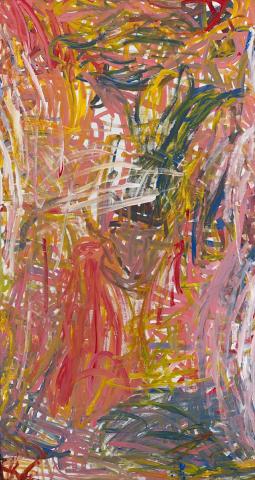BUSH (EMILY'S) DREAMING, 1996
EMILY KAME KNGWARREYE
synthetic polymer paint on linen
230.0 x 124.0 cm
inscribed verso: artist's name, title, size, cat. EKK-5-96
Commissioned by the Chalmers Family on MacDonald Downs Station, bordering Delmore Downs Station, in 1996
Gallery Gabrielle Pizzi, Melbourne
Private collection, United States of America
Sotheby's, Melbourne, 24 July 2007, lot 172
Private collection, Melbourne
Renowned for the expression of ceremony through her art, Emily Kame Kngwarreye painted the spiritual aspect of her life as it relates to country and Awelye or women's ceremonies. Her mark making and abstract references to ceremonial practice identifies the relationship between individual, country, ceremony and ancestors. Ceremony, as expressed through narrative dance and body decoration, reinforces knowledge about such staples as bush foods and water sources, as well as teaching basic social codes and obligations. Through such paintings, Emily passed on her knowledge to those who follow her.
In the 1990s Emily Kngwarreye emerged as one of Australia's leading painters and her works became sought after on an unprecedented scale. Kngwarreye's mark making revealed a strength and sureness of hand that delivered an exuberance of gesture. Her paintings were constructed of various elements that over time were added to or eliminated from the surface of the canvas. Underlying grids structure the compositions, sequences of dots aligned between or over dots, dashes and linear marks, meandering lines and areas of dots applied on dots that allow a build up of colour. These elements constitute the artist's lexicon and are used separately or in varying combinations thus allowing her work to evolve and be constantly fresh.
This vibrant painting belongs to a group of works produced between 1995 and 1996. This phase of her production was characterised by tangled massing of lines sometimes scrawled across the canvas. Scribbled in character, these rapid, multicoloured marks evoke the spiky angularity of desert grasses and contrast the solid meandering lines of the preceding yam paintings. Sometimes translucent in nature and at other times thick and textural, their immediacy shows a speed and energy in brushwork.
Emily's career began in the late 1980s, and in the years until her death in 1996, she produced a body of work which radically altered the way in which we see and understand modern Aboriginal art. For most of her life she lived with little contact with the outside world. While much has been made of the way in which we might view her work in parallel with modern, non-indigenous abstraction, we must first recognize her achievement as a truly inventive and original contribution to Aboriginal art.
CRISPIN GUTTERIDGE
